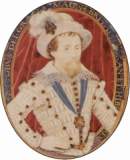Another opinion from James I/VI – this time on football:
Certainly bodily exercises and games are very commendable, as well for banishing of idleness as for making his body able, but from this compte [list] I debarred all rumling violent exercises as the football. (Basilicon Doron, 1599)
Football in those days was certainly a much more violent affair than the game played according to rules today. It seems the football hooligans could often be found on the field, rather than surrounding it. James was not the only one and by no means the first who held this opinion.
It seems likely that the game arrived in Britain with the Normans [1]. It was played between neighbouring towns and villages. The teams had no set number of players, it would just be a mass of people trying to drag an inflated pig’s bladder by whatever means over the goal (eg. markers at the end of a town). A lively description of such a game can be found in the opening pages of Ariana Franklin’s The Assassin’s Prayer [2]. We have various records of people getting killed in the process of these games, often due to players wearing knifes. It is not known when kicking the ball became part of the game, the earliest evidence is from the 13th century.
James I/VI was by no means the first monarch who was against football: In 1314, a game called football was banned by the Lord Mayor of the City of London on behalf of King Edward II.
In 1363 his son, Edward III, issued a declaration prohibiting under penalty of imprisonment among other things “handball, football, or hockey”.
In 1410 Henry IV regarded the game as a misdemeanour and imposed a fine of 20 S on mayors and bailiffs in towns where football was played.
An ancestor of the James of the above quote, James I of Scotland, tried to ban the playing of football in 1424.
The first description of “football” as a ball comes from Juliana Berners, who is thought to have been a prioress of Sopwell Priory in the 15th century. In the Boke of St Albans she describes “a certain rounde instrument to play with …it is an instrument for the foote and then it is calde in Latyn ‘pila pedalis’, a fotebal” [3] and apparently considered it socially acceptable for a football to be included in medieval English Heraldry.
There is an account from 11 April 1497 of a sum of money “giffen [given] to Jame Dog [James Doig] to b[u]y fut ballis to the King”[4]. Somehow, I find it difficult to visualise Henry VII playing football, who was then 40 years old. Though the balls might have been for his children.
After all, the credit for the first record of football boots goes to his son Henry VIII. In 1526 he ordered “45 velvet pairs [of boots] and 1 leather pair for football” [5], though it is not clear whether these were for the king himself. Is there any connection with him all of a sudden falling in love with Anne Boleyn in the spring of that year [6]? He might have wanted to impress her with his proficiency at the sport.
Wikipedia goes on to say that Henry “later banned the game in 1548 it because it incited riots”. As Henry died in January 1547 it would be difficult even for him to ban anything a year later.
Closer to James, we have a description of his mother, Mary Queeen of Scots, as a spectator. While she was imprisoned at Carlisle Castle, Cumbria, in 1568, she watched “20 of her retinue played at football before her for two hours very strongly, nimbly, and skilfully”.
And we even know of James himself being entertained with a game in 1615 when visited Wiltshire. Apparently the villagers had not read the Basilicon Doron!
Notes:
1. The following information is based on ‘Medieval Football’, Wikipedia. URL: http://en.wikipedia.org/wiki/Medieval_football Date accessed: 9 Feb 2011
2. Ariana Franklin, The Assassin’s Prayer. Bantam Press, London, 2010. ISBN 978-593-06353-8 (US: A Murderous Procession)
3. Francis Peabody Magoun, ‘Football in Medieval England and Middle-English literature’, The American Historical Review, vol 35, no 1, 1929, quoted on Wikipedia
4. Morris Marples, A History of Football, Secker and Warburg, London, 1954, p 32, quoted on Wikipedia
5. Marples, p 66, quoted on Wikipedia
6. Antonia Fraser, The Six Wives of Henry VIII. Phoenix, London, 2002, ISBN 978-1-8421-2633-2, p 157
Tags: Medieval Life, Scotland


Leave a reply